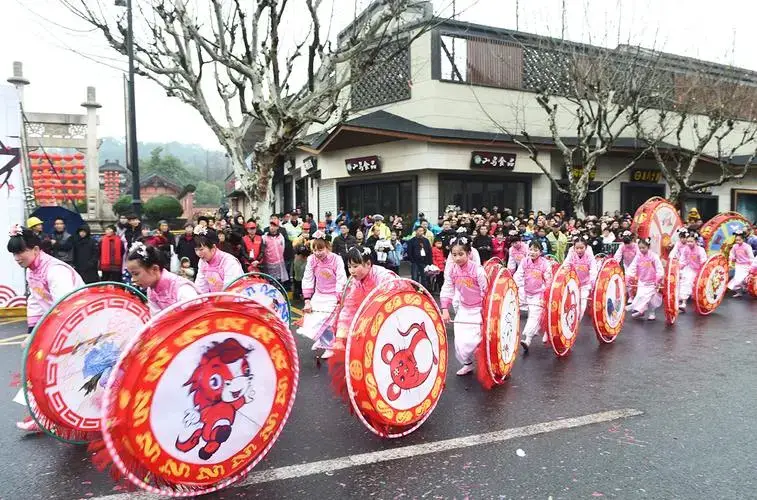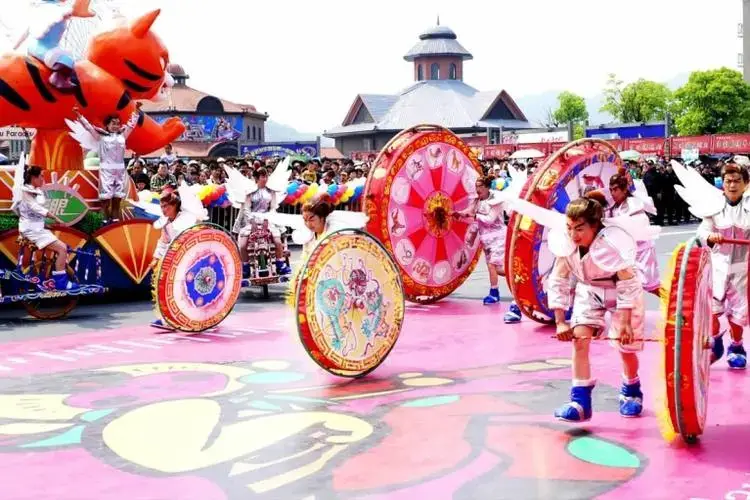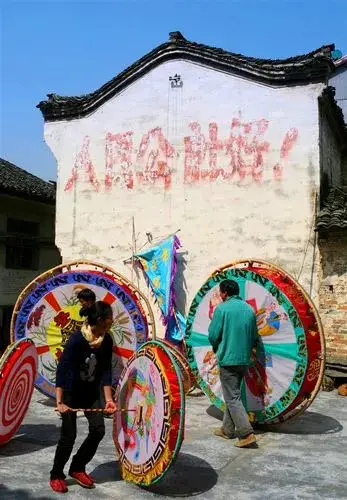Ma Xiao Rolling Lanterns were created by the people of Lin’an County to welcome Empress Dowager Xiao Hui during her provincial visit. Made of pine wood and bamboo, they are crafted into disc shapes with long sticks at their axes and adorned with fabric decorated with beautiful patterns. This form of lantern is not only aesthetically pleasing but also rich in local characteristics, showcasing the craftsmanship of the local residents and their respect for the imperial family, while also reflecting the charm of folk art.
History of Ma Xiao Rolling Lanterns
According to the records of “Lin’an County Annals,” Ma Xiao Rolling Lanterns harbor a profound history and touching stories. This unique art form was meticulously created by the common people of Lin’an to welcome Empress Dowager Xiao Hui back to her hometown.

Empress Dowager Xiao Hui, affectionately known as Lady Shao by the locals, originally hailed from Shaojia Village (now renamed Yangxi Village) at the foot of Mamian Mountain in Qingliangfeng Town, Lin’an City. According to “Ming History,” Lady Shao, in her childhood, came from humble beginnings, to the point where her family’s financial situation was so dire that they had to sell her young daughter to a eunuch stationed in Hangzhou at the time, in exchange for their livelihood. However, this unfortunate turn of events paved the way for Lady Shao’s journey to the imperial palace. In the fourth year of Tian Shun (1460), she entered the palace and became a palace maid to the then Crown Prince, Zhu Jian Shen, who later ascended the throne as Emperor Xianzong.
Lady Shao was not only exceptionally beautiful but also possessed rare literacy skills, which were highly valued among women of that era. Her combination of talent and beauty ultimately won the favor of Emperor Xianzong. In the twelfth year of Chenghua (1476), she bore a son for Emperor Xianzong (his fourth son), thus being promoted to the rank of noble consort, a prestigious position. By 1519, her grandson Zhu Houzhao inherited the throne, ascending to the imperial seat, and Lady Shao was honored as “Empress Dowager.”
Despite her esteemed status, Lady Shao never forgot her roots in the small village of Qingliangfeng Town in Lin’an City. Whenever the Year of the Dragon, the year of her birth, came around, she would return to her hometown with precious gifts from the palace to celebrate with her fellow villagers. Her return was a grand celebration for the locals. To express their respect and welcome, the villagers spontaneously organized and created the unique art form of Ma Xiao Rolling Lanterns.
The production of Ma Xiao Rolling Lanterns is elaborate. High-quality pine wood and bamboo are selected as the framework, meticulously crafted into disc shapes. A long stick is cleverly installed at the axis, allowing the lanterns to rotate flexibly. The outer perimeter of the disc is made of fabric with various beautiful patterns sewn on, featuring vibrant colors and exquisite details, making the lanterns not only practical but also works of art.
When the Empress Dowager returned to her hometown, the villagers held these Ma Xiao Rolling Lanterns, lining up on both sides of the Huizhou-Hangzhou Ancient Road, warmly welcoming her return. The lanterns slowly rotated in the night, the colorful patterns shining brightly under the lamplight, as if paying the highest respect to this returning royal figure.
This tradition continues to this day, with Ma Xiao Rolling Lanterns becoming an important prop for local celebrations or festivals. It is not only an artistic expression but also a memory of history for the people of Shaojia Village in Qingliangfeng Town, Lin’an City, and a heritage of culture. Through Ma Xiao Rolling Lanterns, we seem to be able to transcend time and space, feeling the joy and excitement of that historical moment and experiencing the deep respect of the local people for Empress Dowager Xiao Hui and their profound emotions for her family and village.
Today, Ma Xiao Rolling Lanterns have surpassed their original significance, becoming a cultural bridge connecting the past and present, the royal and the folk. Each performance of the rolling lanterns is a reproduction of that historical period and a continuation and promotion of traditional culture.
Style of Ma Xiao Rolling Lanterns
Ma Xiao Rolling Lanterns, this unique art form, holds a significant position in the historical and cultural heritage of Lin’an County. Its performance forms are diverse, and the number and combination of lanterns vary. Among them, the performance consisting of 12 lanterns is particularly eye-catching.
These 12 rolling lanterns vary in shape and height. Two towering lanterns stand at a height of 2.2 meters, resembling giants standing majestically in the performance lineup; four lanterns standing at 2 meters tall follow closely behind, sturdy and solemn; while six lanterns standing at 1.2 meters tall shuttle between them like elves, agile and lively. The decoration of these lanterns is also meticulous, with finely painted patterns of the Chinese zodiac, abundant harvests, and Eight Immortals on both sides. Every detail embodies the painstaking effort and wisdom of the craftsmen.

When this procession of rolling lanterns sets off, the scene is magnificent and awe-inspiring. Large gongs on both sides sound, deafening the ears, adding endless majesty and momentum to the entire procession. Accompanying the lanterns are traditional props and ceremonial items such as two arquebuses, four fire meteors, knives, forks, and flags, enriching the visual effects and infusing the entire performance with a strong folk and ethnic flavor.
At the forefront of the rolling lantern procession are the prominent Wealth God lantern and Name lantern. They glitter, symbolizing both wealth and fame. Following them are two 2.2-meter-tall large lanterns, one depicting vivid Chinese zodiac animal patterns, each animal lifelike, as if about to leap off the lantern; the other depicting phoenixes and peonies, with the phoenixes soaring high and the peonies blooming, symbolizing auspiciousness and prosperity.
These twelve lanterns do not exist in isolation but are accompanied by twelve car lanterns on both sides. These car lanterns depict patterns such as the Wealth God, Mountain God, Buddha, Judge, Carp Spirit, and Eight Immortals, with each character lifelike, as if about to step down from the lanterns to interact with the audience. These car lanterns complement the rolling lanterns, collectively forming a colorful picture.
The finale is the musical instrument and drum array. The drums resound loudly, and the musical instruments play melodiously, creating a rich musical atmosphere for the entire performance. During the performance, two people push large wheels while another person rolls small wheels forward. Their movements are coordinated, resembling an ancient dance. As their steps change, the rolling lanterns evolve into various shapes, such as double dragons emerging from water, double dragons playing with water, figure-eight shapes, and twisting iron chains, captivating the audience.
The unique and creative performance form of Ma Xiao Rolling Lanterns integrates various art forms such as music, dance, and painting, showcasing a strong folk and ethnic color. Each performance of the rolling lanterns is a feast for the eyes and ears, allowing the audience to appreciate the charm and profound cultural heritage of traditional culture. This performance not only enriches the local cultural life but also serves as a cultural bridge connecting
the past and present, tradition and modernity. Through the performance of Ma Xiao Rolling Lanterns, we can gain a deeper understanding and appreciation of the profoundness and unique charm of traditional Chinese culture.
Inheritance Status of Ma Xiao Rolling Lanterns
Ma Xiao Rolling Lanterns, this unique art form, has undergone more than five hundred years of baptism by wind and rain. However, historical changes once caused this traditional art to be interrupted for a period, putting it at risk of being lost. Fortunately, in 1983, the local government actively intervened, committed to excavating and protecting this cultural heritage. With the guidance and instruction of folk artists, Ma Xiao Rolling Lanterns revived.

After several years of restoration and development, in 1986, Ma Xiao Rolling Lanterns once again took to the stage, shining brightly in the Lantern Festival performance in Lin’an County. The audience was attracted by its exquisite performance and profound cultural heritage, and this traditional art once again won applause and praise from the people. Since then, the influence of Ma Xiao Rolling Lanterns has gradually expanded. It not only participated in the 2002 Expo, but also achieved remarkable results in the 2003 West Lake Expo performance, such as winning the Lantern Art Gold Award and Excellent Program.
With the passage of time, Ma Xiao Rolling Lanterns have received increasing attention and recognition from all sectors of society. In 2009, this art form was awarded the honor of Zhejiang Intangible Cultural Heritage, which is recognition of its historical value and cultural significance, as well as acknowledgment of its inheritance and protection efforts. Today, Ma Xiao Rolling Lanterns have become one of the cultural calling cards of Zhejiang Province, showcasing the rich cultural heritage and unique artistic charm of Zhejiang to the world.
The inheritance and development of Ma Xiao Rolling Lanterns not only respect history but also inherit culture. In the future, we look forward to this art form shining brightly on a broader stage and contributing to the inheritance and development of Chinese culture.
Inheritance of Ma Xiao Rolling Lanterns
Ma Xiao Rolling Lanterns, hailed as a rare flower of folk dance in Jiangnan, not only showcases art but also carries the unique cultural information and characteristics of western Zhejiang folk customs at a deeper level. Every rotation of the rolling lanterns, every flicker of light, seems to tell the history and culture of western Zhejiang people. The performance form, production techniques, and accompanying folklore legends of the rolling lanterns provide rich research materials for us. Through these, we can gain a deeper understanding of the economic and political development process of western Zhejiang and feel the local customs and practices of this land. Therefore, Ma Xiao Rolling Lanterns are not just a dance or art form; they are a witness to an era, a valuable material for studying the economic and political development of western Zhejiang. Protecting and inheriting Ma Xiao Rolling Lanterns means protecting and inheriting the history and culture of western Zhejiang.
reference
“1500 years ago, the imperial capital once warmly welcomed the empress dowager for her provincial visit, and Lin’an’s Ma Xiao Rolling Lanterns were included in the provincial intangible cultural heritage.” – Hangzhou Daily [Accessed March 15, 2015]
“Ma Xiao Rolling Lanterns.” – Zhejiang Provincial Intangible Cultural Heritage Website [Accessed March 15, 2015]